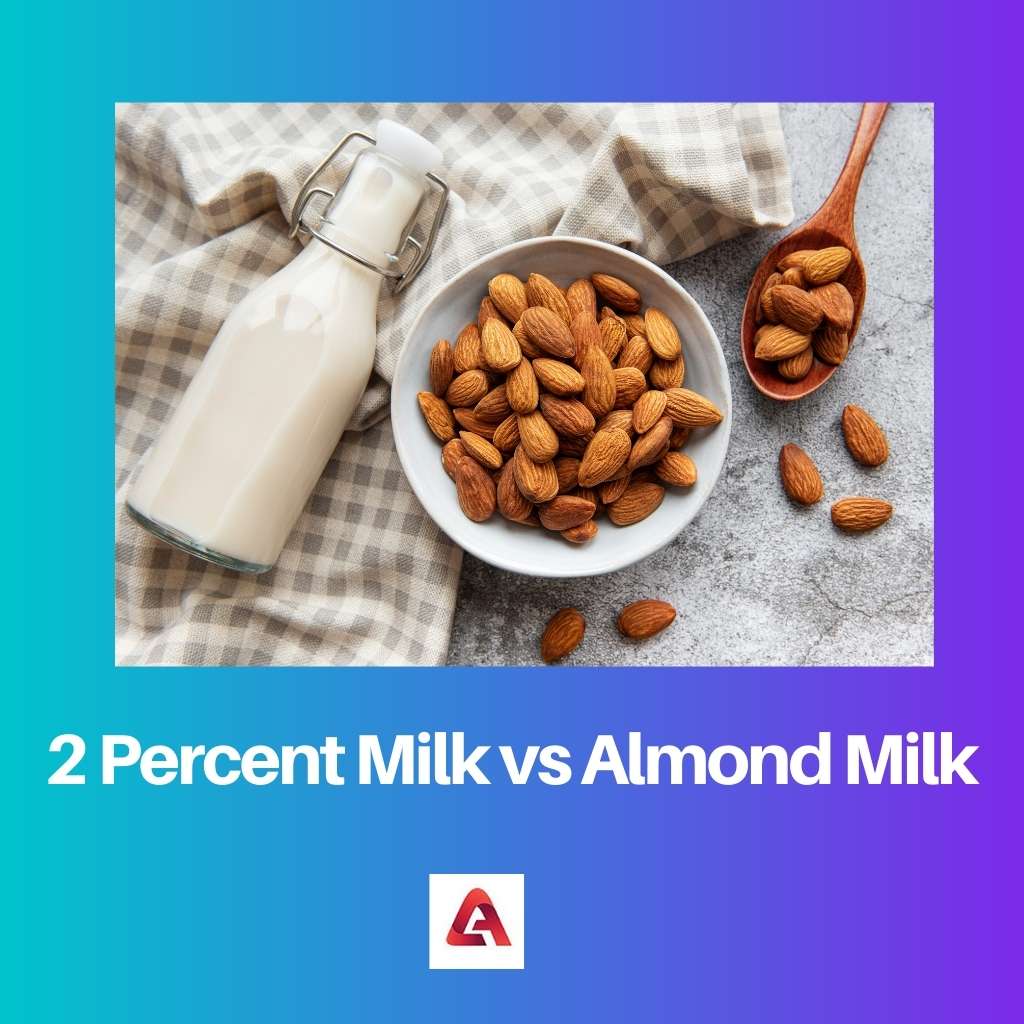When the fat level of the milk is lowered to 2%, it is referred to as “normal milk.” The numerical number “2” here denotes the presence of fat in the milk’s weight. Reduced-fat milk is defined as 2% milk that has lower fat content than whole milk.
Almond milk is vegan-free, plant-based milk with a nutty flavor and creamy texture made by crushing almonds in water and then filtering away the solids. When compared to 2 percent milk, one serving of Almond Milk has substantially fewer calories.
Key Takeaways
- 2 percent milk is a dairy product with reduced fat content, while almond milk is a plant-based alternative made from almonds and water.
- 2 percent milk contains more protein, natural vitamins, and minerals than almond milk.
- Almond milk is lower in calories and suitable for those with lactose intolerance or following a vegan diet.
2 Percent Milk vs Almond Milk
The difference between 2 percent milk and almond milk is that when the fat content of milk is lowered to 2%, it is referred to as a state of normal milk. The numerical number “2” denotes the presence of fat in the milk’s weight. Because 2 percent milk has lower fat content than whole milk, it is referred to as reduced-fat milk. Almond milk is vegan-friendly, plant-based milk with a nutty flavor and creamy texture that is made by crushing almonds in water and then filtering off the solids.

A serving of 2% milk contains 120 calories. 1 percent milk, skim milk, whole milk, and a variety of other milk can be used as alternatives for 2 percent milk. One cup of 2 percent milk contains about 5 grams of fat, which is about 3 grams less than whole milk.
As a result, there isn’t much of a difference in fat content between 2% milk and whole milk. After the age of one, 2% milk is commonly recommended for babies.
Almond milk is a low-fat milk option. Almond milk contains only 3 grams of fat per cup, which is 40% less fat than 2 percent milk.
Almond milk can be given to babies as soon as they reach one year old since it contains a large amount of Vitamin D and calcium, both of which are beneficial to children’s bones. Protein is scarce in almond milk.
The amount of protein in this dish is low, at roughly 2 grams. Almond milk is lactose-free, making it an excellent option for vegans and lactose-intolerant persons.
Comparison Table
| Parameters of Comparison | 2 Percent Milk | Almond Milk |
|---|---|---|
| Extracted from | Cow | Almond |
| Substitutes | 1 percent milk, skim milk, whole milk | Soy milk, Rice milk, Coconut milk, Cashew milk, Oat milk |
| Protein Content | High (8 gram) | Almost nil |
| Fat Content | High (5 gram) | Low (3 gram) |
| Calories Content | High (120) | Low (40) |
What is 2 Percent Milk?
One cup of 2 percent milk contains around 5 grams of fat, which is approximately 3 grams less than whole milk. As a result, the fat content of 2% milk and full milk is nearly identical.
After the age of one, 2 percent milk is commonly recommended for babies. Cow’s milk is required for brain development in babies under the age of two.
When the fat level of milk is lowered to 2%, it is referred to as “normal milk.” The numerical value “2” denotes the presence of fat as a proportion of the milk’s weight. Because 2 percent milk contains a lower percentage of fat than whole milk, it is referred to as reduced-fat milk.
A serving of 2 percent milk has 120 calories in it.
Substitutes for 2 percent milk include 1 percent milk, skim milk, whole milk, and a variety of others. 2 Perfect Milk is a high-protein beverage.
This milk has roughly 8 grams of protein per serving. This is a dairy product that contains lactose because it is made from 2% milk received from cows.
Lactose intolerant individuals are unable to consume this milk.

What is Almond Milk?
Almond milk can be given to babies as soon as they reach one year old since it is high in Vitamin D and calcium, both of which are beneficial to children’s bones. Protein is in limited supply in almond milk.
Almond milk contains no lactose, making it an excellent alternative for vegans and lactose-intolerant individuals.
Sugar-free Almond milk has 40 calories per cup serving. Soy milk, Rice milk, Coconut milk, Cashew milk, Flaxseed milk, Hemp milk, Oat milk, and others are some of the Almond milk substitutes.
Almond milk is low-fat milk that is available. Almond milk contains only 3 grams of fat per cup serving, which is 40% less fat than 2 percent milk.
Almond milk is vegan-friendly, plant-based milk with a nutty flavor and creamy texture made by crushing almonds in water and then filtering off the solids. When compared to 2 percent milk, one serving of Almond Milk has far fewer calories.
The amount of protein in this dish is nearly non-existent, at roughly 2 grams.

Main Differences Between 2 Percent Milk and Almond Milk
- 2 percent milk is referred to as a state of normal milk when the fat content is reduced. Here the numerical value “2” refers to the Presence of fat percentage to the weight of the milk. On the other hand, Almond milk is a type of vegan free and plant milk possessing a nutty flavor and creamy texture, which is manufactured by grinding almonds in water and later filtering out the residues.
- 2 percent milk contains a comparatively lower percentage of fat than whole milk; therefore, it is called reduced-fat milk. One serving of 2 percent milk possesses 120 calories. On the other hand, one serving of Almond Milk contains much fewer calories as compared to 2 percent milk. One cup serving of Sugar-free Almond milk possesses 40 calories.
- Some of the substitutes to 2 percent milk are 1 percent milk, skim milk, whole milk, and many more. On the other hand, some of the substitutes for Almond milk are Soy milk, Rice milk, Coconut milk, Cashew milk, Flaxseed milk, Hemp milk, Oat milk, and many more.
- The amount of fat present in one cup serving of 2 Percent Milk is around 5 grams, which is around 3 grams less than whole milk. Thus, there is not much difference between 2 Percent milk and whole milk fat content. On the other hand, Almond milk is one of the low-fat milk available. The amount of fats present in one cup serving of Almond milk is only 3 grams, which is forty percent less fat content than 2 percent milk.
- 2 percent milk is good for babies after they turn 1. Bodies of babies under the age of two require cow’s milk for brain development. On the other hand, Almond milk can be given to babies when they turn 1, as it contains a good amount of Vitamin D and calcium, which is great for kids’ bones.
- 2 perfect milk is a great source of Protein. One serving of this milk contains around 8 grams of protein. On the other hand, almond milk is a bad source of Protein. The amount of protein present here is almost negligible, which is around 2 grams only.
- 2 percent milk is obtained from cows. Thus, this is a dairy product and contains lactose. This milk can not be consumed by those people who are lactose intolerant. On the other hand, Almond milk does not contain lactose at all; therefore, this is a great choice for vegans and lactose-intolerant people.





